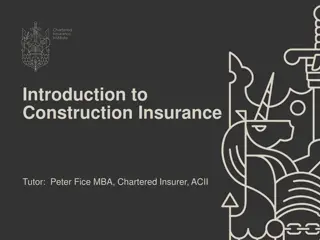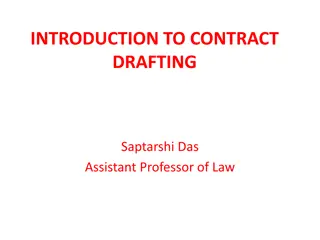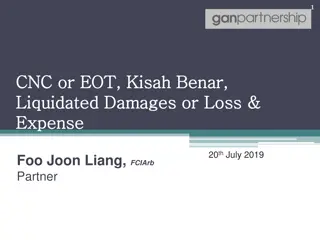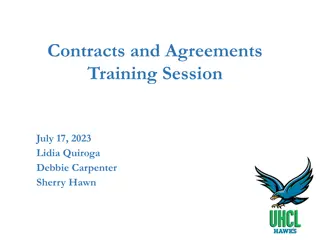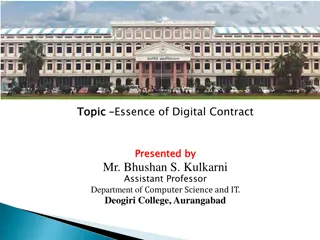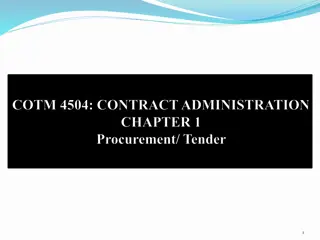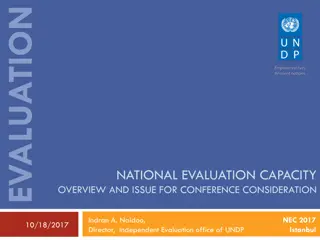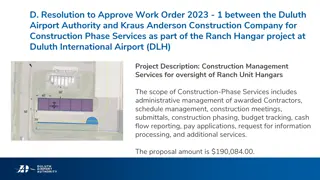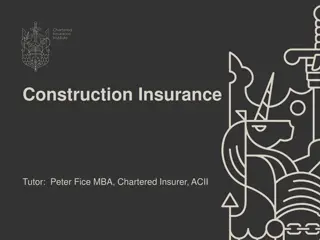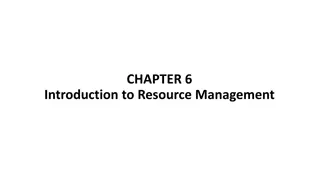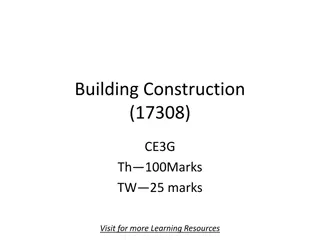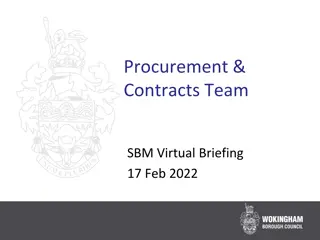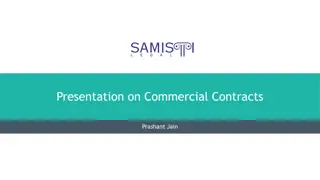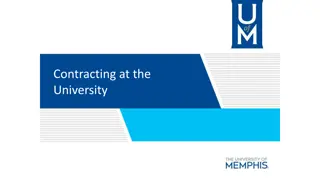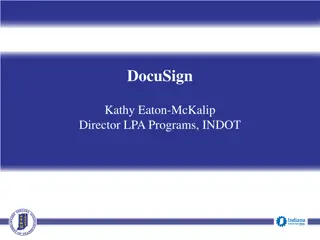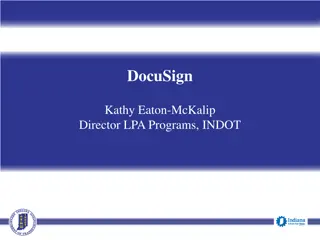Comparison of JCT and NEC Contracts in the UK Construction Industry
JCT and NEC are main contracts used in the UK construction industry. JCT, established since 1931, emphasizes a traditional style, while NEC, newer and based on collaborative ethos, emerged from previous ICE conditions. The contracts differ in their approach and usage, with JCT being more established in the industry but NEC gaining popularity, especially in the public sector. The comparison includes details on contract history, usage trends, main works contracts, and contract structures.
Download Presentation

Please find below an Image/Link to download the presentation.
The content on the website is provided AS IS for your information and personal use only. It may not be sold, licensed, or shared on other websites without obtaining consent from the author. Download presentation by click this link. If you encounter any issues during the download, it is possible that the publisher has removed the file from their server.
E N D
Presentation Transcript
NEC vs JCT 7thJune 2019
NEC v JCT Fergus Aitken BSc MRICS MAPM YORbuild2 Programme Manager East Riding of Yorkshire Council Mr NEC Chris Bourne BSc (Hons) MRICS YORbuild2 Framework Manager Scarborough Borough Council Mr JCT
History JCT NEC Main contract used within the building sector of the UK construction industry since 1931 The New Engineering Contact / Engineering and Construction Contract was first published in 1991 Now in its 4th edition published June 2017 Latest editions were published in 2016. Over 60 different versions JCT claims pre-eminence due to its longevity NEC is the modern kid on the block (but emerged from previous ICE conditions) Traditional (or master and servant ) style of contract Aims to create a collaborative/partnering ethos, with a proactive approach Building industry are used to JCT as it s been around for a while and the building industry s set up complements its use, but NEC is now well established NEC3 is now all but mandated for public sector projects (following the Cabinet Office s endorsement in 2008). Civils sector are used to NEC
National Construction Contracts and Law Survey 2015 This year (2018) JCT has shown a marked growth, and is now at levels not seen since 2011. NEC, which had been growing year on year, has contracted and has returned to the levels that we saw in 2011. Use of bespoke contracts has fallen from 11% to 5%.
Main works contracts JCT (2016) NEC3 (2013) Standard Building Contract - 3 versions Intermediate Building Contract - 2 versions (1 with Contractor design) Major Project Construction contract Design and Build Contract Management building Contract Construction Management Contract Constructing Excellence Contract NEC3/NEC4 Engineering and Construction Contract Minor Works building Contract - 2 versions (1 with Contractor design) NEC3/NEC4 Engineering and Construction Short Contract = 12 works contracts = 2 works contracts
Contract structure JCT (2016) NEC3 (2013) Articles of Agreement Core clauses Recitals Main option clauses A-F Articles Secondary option clauses Contract particulars Schedule/Shorter schedule of cost components Conditions Contract Data Schedules
Generally JCT (2016) NEC3 Use traditional contract terminology (legalese), Contracts are intended to provide improvement/ dispute avoidance through three main aspects As contracts tested by legal challenges over a considerable period, it s argued that JCT contracts provide greater certainty of legal meaning than NEC contracts. Flexibility cover building and civils/ pick and mix approach Clarity and simplicity use of ordinary language, no cross references, avoid subjective terms However they are very detailed, contain lengthy sentences, lots of defined terms, lots of cross referencing & can be difficult to understand Stimulus to good management collaborative approach, PM regime, proactive processes to agree variations and claims as work progresses Have limited details for processes with timetables to manage issues.
Project Management/ Contract Administration JCT NEC Are administered by an Architect / Contract Administrator. There is also a Quantity Surveyor to carry out valuations (including variations and loss and expenses matters). Include roles for: a Project Manager to manage and administer the contract and A clerk of works may also be appointed to act as an inspector. a Supervisor to check that work is carried out in accordance with the Works Information. The Architect / Contract Administrator role generally doesn t involve the pro active process driven approach required for the Project Manager to NEC contracts. NEC contracts are driven by a set of processes that involve the parties working together to resolve issues as they occur.
Project Management/ Contract Administration JCT NEC Select a CA with the skill to tightly control the account throughout the project - goodwill can disappear when the parties have unresolved claims for time and money (arising from relevant events), which are difficult to unravel, and there is pressure to close the account and switch attention to other projects It s important that the Project Manager has appropriate qualities, project management skills and understanding of NEC contracts to pro actively manage the contract and to foster collaborative working with the contractor. So choose your project manager carefully, as the contract depends on solid project management. PM s often administer NEC contracts in a similar way to JCT contracts which is best avoided.
Management input = Similar management input overall
Collaboration/ Partnering JCT NEC The Parties shall work with each other & with other project team members in a co- operative and collaborative manner, in good faith & in a spirit of trust & respect. To that end each shall support collaborative behaviour & address behaviour which is not collaborative (Schedule 8, Supplemental Provisions, item 1) The Employer, the Contractor, the Project Manager and the Supervisor shall act as stated in this contract and in a spirit of mutual trust and co-operation. (Clause 10.1 Core Clause) This is included as an option the default is that it applies, but it can be omitted. the contract is limited in terms of processes that involve a collaborative approach to manage issues. This is included as the first of the core clauses reflecting the importance of such relationships as an integral aspect of the processes for managing NEC contracts, e.g. in relation to early warnings and compensation events.
Pricing JCT NEC Option A Priced Contract With Activity Schedule With quantities (Lump sum contract) Employer provides drawings and bills of quantities specifying quantity and quality of work Option B Priced Contract With Bill of Quantities Without Quantities (Lump sum contract) Employer provides drawings together with a description of works and either a specification or work schedules Option C Target Contract With Activity Schedule Option D Target Contract With Bill of Quantities With Approximate Quantities (Re- measurable) Employer provides drawings and approximate bills of quantities. Option E Cost Reimbursable Contract Option F Management Contract The NEC Contract doesn t include provisional sums The JCT Contract contains provisional sums
Payment JCT (2016) NEC The JCT contract payment section is clear, is all in one section (clause 4) and easy to follow. Listed items permits payment for materials off site In the NEC contract it is located in three different locations clause 5, Y(UK)2 and Contract Data Part 1. Option A - Activity schedule - items need to be 100% complete before payment is made. Encourages Contractor to stick to programme Payments are generally calculated by QS based upon assessment of work done plus materials, following an application made by the Contractor. Option B BofQ payment is based on a remeasure + proportions of lump sums Options C-F payment is based upon forecast of defined cost to be paid before next assessment + Fee
Key requirements Time These areas are key: Cost - timely agreement of the value of changes Time - how it deals with the programme Quality inspection arrangements and defects resolution Risk how these are identified and resolved +Risk Cost Quality 16
Comparison The following slides compare the JCT Standard Building Contract (SBC) without quantities 2016 with NEC3 Engineering and Construction Contract 2013 with Main Option A as these are understood the most widely used (JCT D&B being a close second)
Cost - variations/ claims generally JCT (2016) NEC3 Variations are valued by: Assessment of change is radically different in NEC agreement between the Employer and the Contactor, Based upon the pre-assessment of change based on forecast costs not tendered rates and prices quotations accepted by the Architect/ CA, A Contractor should be neither better nor worse off for an Employer-driven change event occurring or by the QS using the Valuation Rules on the basis of: relevant rates and prices in the contract for work of a similar character or in the absence of such at fair rates and prices or Dayworks. Any extension of time & associated costs must be included in each CE However tendered rates and prices can be used if parties agree
Cost - variations/ claims generally JCT (2016) NEC3 Loss and expense payment is allowed where there is delay in providing possession of the site to the contractor or where progress is affected by Relevant Matters. Dealt with under the compensation events procedure and payment is assessed on the basis of the effect on forecast / actual cost (at open market / competitively prices or rates in the Contract Data as relevant) plus a tendered fee percentage (for profit and any costs not covered elsewhere). Any loss and expense is captured in compensation events JCT provides a number of subjective tests for determining if certain events give grounds for recompense to the contractor. An example of this is weather, JCT refers to exceptional adverse weather conditions, which is subjective NEC generally relies on more objective tests e.g. NEC uses a worse than 1 in 10 year approach to weather, which is objective. Compensation events are allowed for a range of issues defined in the contract including a catch all for a breach of contract by the Employer which is not one of the compensation events in this contract. There s no other provision for the contractor to recover payment in respect of such issues. In JCT the contractor is only obliged to claim for more time and money after the risk event has occurred, which puts the employer in an extremely difficult management position
Cost - pros JCT (2016) NEC3 The JCT provisions to value variations may be less onerous in terms of input than compensation events procedure under NEC contracts, for example where this is on the basis of existing rates and prices As variations shouldn t occur because of the fault of the contractor, the effect on forecast / actual cost is a fairer basis for valuation (rates for similar work may be skewed to benefit either the contractor or the Employer depending on the tendering contractor s pricing strategy / cash-flow requirements). NEC includes a defined process with a clear timetable (extendable by agreement) for notifying, evaluating and implementing compensation events. Compensation events are evaluated in terms of both cost and time (delays to the Completion Date and key dates);
Cost pros NEC3 (2013) Both the contractor and the PM have responsibilities to notify and respond to relevant compensation events, for example: Time barring - if the contractor fails to notify an existing or expected CE within 8 weeks of becoming aware of it, he is not entitled to claim for the event unless the PM should have notified the contractor of the event, but failed to do so. Deemed acceptance If the PM does not respond to a notification of an event notified by the contractor in accordance with the required timetable then the event is treated as a CE and the contractor submits a quotation. If the PM fails to respond to a quotation by the contractor in accordance with the required timetable (except for a proposed change / instruction) then quotation is deemed to be accepted.
Cost - cons JCT (2016) The inclusion of several pricing options for variations may result in disagreements as to which option applies. Claims for extensions of the contract period are notified and evaluated under separate conditions of contract to those for cost; there s no specific requirement to use the contractor s programme to evaluate extensions. The provisions for loss and expense payments are without prejudice to any other rights and remedies that the contractor may possess. Except when the quotation procedure is used the absence of a clear timetable for evaluating all variations and claims (for both cost and time concurrently) in real time increases the potential for issues to build up during the contract and increase uncertainty as to the final outcome.
Programme/ Delays JCT (2016) NEC3 The contractor is only required to submit a programme at the start of the contract and provide a revised programme if an extension is granted (although the preliminaries may require the contractor to update the programme to show progress). Include detailed requirements for programmes (including resources for each operation). Revised programmes, showing actual progress for each operation and its effects on the timing of remaining work are required including at specified intervals and in relation to compensation events; The contract doesn t require the programme to be accepted by the Architect / CA, or to be used for monitoring progress, or assessing extensions. each programme is subject to acceptance by the Project Manager.
Programme/ Delays JCT (2016) NEC3 The absence of a requirement for an accepted detailed programme updated to show actual progress, to be used for evaluating delays and extensions, increases the potential for issues to build up through the contract and increase uncertainty as to the final outcome. The programme is a key tool for managing the contract; the accepted programme is used to assess delays and extensions to the contract in real time under the compensation events procedures. The programme is often described as the beating heart of the contract.
Practical Completion JCT NEC3 (2013) JCT which relies upon a subjective judgement of practical completion determined at the time. NEC identifies a state at completion which is defined within the works information JCT requires the issue of a non completion certificate before LAD s can be withheld
Quality/ Defects JCT (2016) NEC3 Defects after completion are to be rectified within a reasonable time Defects after completion are to be rectified within the defects correction period, a specific time period With NEC, there is an obligation on both contractor and supervisor to notify each another of defects as soon as they are aware of them, providing a more open process for highlighting and dealing with defects. This same obligation is not found in JCT.
Risk management JCT NEC3 (2013) Risk allocation is largely fixed Risk allocation can be better tailored In the JCT contract ground risk is with the contractor. However, the NEC contract uses the ICE foreseeability test in relation to ground conditions. Early warning is required if time, quality or cost could be impaired. Failure to notify an issue may adversely the affect the valuation of a compensation event arising from it in relation to the contractor or Employer (depending on the party failing to give notice). It is not uncommon for JCT contracts to be extensively modified to transfer risk Both parties are required to list matters to be included in Risk Register in Contract Data
Early warning JCT (2016) NEC3 JCT contracts don t include a proactive early warning procedure (to pre-empt problems) and generally rely on the provisions in the contract to deal with issues when they occur. One of the stimuli to good management under NEC is the early warning system. The aim is to pre-empt potential problems and mitigate their impact. Early warning provisions involve the maintenance of a risk register and place obligations to notify each other if a relevant issue occurs and to attend and co-operate at a risk reduction meeting. The exception to this is the JCT Construction Excellence contract which contains some risk management provisions. Failure to notify an issue may adversely the affect the valuation of a compensation event .
Summary pros and cons
Summary JCT - pros Building industry is arguably better geared up for it Arguably provide greater certainty of legal meaning Some may prefer its specific contract structure More familiarity within the industry
Summary JCT - cons Contain legalese Are very detailed, contain lengthy sentences, lots of defined terms, lots of cross referencing & can be difficult to understand Have limited details for processes with timetables to manage issues. Contracts tend to get left in drawer Programme is not a binding contract document Late claims not time barred Rigid risk management procedures
Summary NEC - pros Endorsed for public sector by government Are flexible Claim to be clearer and simpler to understand Act as a stimulus to good management, potentially providing greater certainty of outcome in terms of cost and time Contain good procedures for managing risk Encourage parties to work together Use objective tests (rather than subjective)
Summary NEC - cons Contract needs to sit on desk If not proactively managed, properly understood and resourced from outset problems can arise Requires careful drafting (e.g. Works Information) Lack of industry awareness in some quarters (even now) Disputes often get resolved by Adjudication so findings remain private
Contract choice So which contract would you choose?: 1. Time which contract is more likely to ensure the project is finished on time 2. Cost which contract will give better value/ more cost certainty 3. Quality which contract will give me a better product 4. Risk which contract is better at dealing with risk Both can be used on the YORbuild2 framework.


